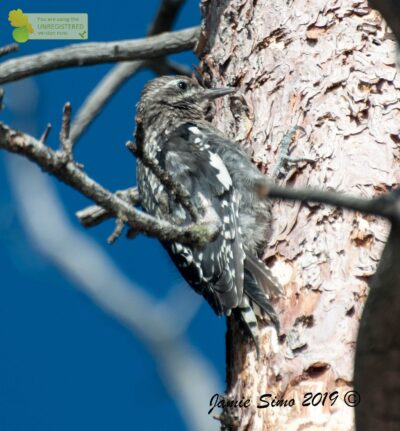Beaver Ranch is a multi-use, 450-acre park operated and managed by a local non-profit, Beaver Ranch Community, in agreement with Jeffco Open Space. The Front Range Birding Company has been leading bird walks there now for three years, and when birding seems slow elsewhere it continues to deliver a good variety of birds. This is despite all the falderol that can go on there on a Saturday morning – cabin rentals, horseback riding, a disc golf course, multiple ziplines, and occasional weddings.
As usual this past Saturday it was hard for us to leave the parking lot because of the slew of initial birds that we had to take note of and try to identify, which is a particularly challenging task this time of year with so many doofy looking youngsters adding their variety of calls to the mix. To begin with we had three species of swallows: Tree, Violet-green, and Barn. Trees and Violet-greens can generally be separated from the other swallows by their bright, white breasts (though immature Violet-greens can be a bit dull looking). The main features to look for in separating Trees and Violet-greens from each other are that the dark hood on Trees comes below the eye while on Violet-greens it ends above the eye, and the Violet-greens have notable white sides to their rumps. One additional attribute to become aware of is that Violet-greens are shorter-tailed, and when looking at perched birds their wingtips project well beyond the tail. Barn Swallow adults can be easily identified because of their deeply forked tail. However, juveniles, though-long-tailed, lack the obvious longer forked tail. Other features to look for are the rusty forehead and throat.
Also, while still in the parking lot, we were treated to a juvenile Red-naped Sapsucker which, though it lacked having any red, did show the characteristic sapsucker white wing patch which on a perched bird appears as a long vertical white bar. Then, there was a family of Red-tailed Hawks – an adult with two shrill begging juveniles. We noted that while the adult had the characteristic “red” tail and the tails of the juvies were paler and more obviously multi-banded, they all three had the diagnostic dark patagium – the leading edge of the wing. And then, there was a beautiful female Western Tanager and a bunch of other cool birds, but we finally got ourselves out of the parking lot and checked out a Yellow Warbler and some Lincoln’s Sparrows in the willows along Casto Creek. A bull moose had been reported in that area, but we regretfully didn’t become acquainted.

The real highlight of the day came in the form of a slew of Virginia’s Warblers. Virginia’s are one of our six regularly occurring breeding warblers found in the foothills west of Denver. The other five are MacGillivray’s, Yellow, Yellow-rumped, Wilson’s, and Common Yellowthroat. Virginia’s spend their winters in southwest Mexico and then migrate north to breed on the mesas and in the canyons of the semi-arid Southwest. Locally, they prefer the dry oak scrub and mountain mahogany of our foothills where they nest on the ground raising on average 3-5 fledglings. However, once these juveniles exhibit enough self-reliance, then it is time for what is known as post-breeding dispersal to find new foraging resources, which can then be a preliminary step towards fall migration. This is what we witnessed on Saturday. I believe that we only saw 2-3 adult Virginia’s and that the rest were youngsters, and it was interesting to see them utilizing willow-alder riparian habitat that was thick with cow parsnips, which in turn were presumably thick with little insects – just what insectivores need. Much fun!

Good birding! Chuck
Beaver Ranch, Aug 6, 2022
30 species
Broad-tailed Hummingbird 9
Turkey Vulture 5
Red-tailed Hawk 3
Red-naped Sapsucker 1
Downy Woodpecker 1
Hairy Woodpecker (Rocky Mts.) 1
Northern Flicker (Red-shafted) 4
Western Wood-Pewee 4
Cordilleran Flycatcher 1
Steller’s Jay 2
Mountain Chickadee 19
Tree Swallow 11
Violet-green Swallow 5
Barn Swallow 4
Ruby-crowned Kinglet 3
Red-breasted Nuthatch 2
White-breasted Nuthatch 4
Pygmy Nuthatch 3
House Wren 2
Mountain Bluebird 1
American Robin 2
Red Crossbill 2
Pine Siskin 9
Chipping Sparrow 1
Lincoln’s Sparrow 5
Red-winged Blackbird 4
Virginia’s Warbler 7
Yellow Warbler 1
Western Tanager 2
Black-headed Grosbeak 1


Comments
Write Comment